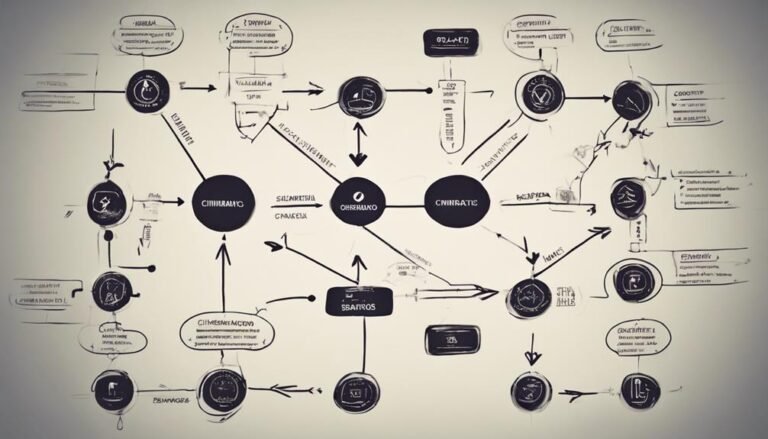Systemizing Business Operations
Efficiency, consistency, and scalability are crucial elements for any thriving business. Systemizing operations is more than just a trend; it's a strategic approach that can revolutionize the way organizations function.
By establishing structured processes and embracing automation, businesses can unlock a myriad of benefits that lead to increased productivity and enhanced performance. But how exactly can businesses go about implementing these systems effectively?
Let's explore the key strategies and tools that can propel your business towards operational excellence.
Key Takeaways
- Efficient processes drive operational effectiveness and enhance productivity.
- Automation and standardization streamline workflows for optimal performance.
- Identifying bottlenecks and implementing automated systems improve efficiency.
- Standardized procedures ensure consistency, quality control, and operational excellence.
Importance of Systemizing Operations
Why is systemizing operations crucial for the efficiency and scalability of a business?
Operational effectiveness and workflow optimization are key factors that drive the need for systemizing operations. By implementing systematic processes, businesses can streamline their workflows, reduce errors, and enhance overall operational efficiency. Process automation plays a vital role in systemizing operations by automating repetitive tasks, reducing manual intervention, and allowing employees to focus on more strategic activities. This automation not only saves time but also leads to performance enhancement across various business functions.
Efficient processes enable businesses to standardize their operations, ensuring consistency in outputs and quality. Through systemizing operations, companies can identify bottlenecks, eliminate redundancies, and improve resource utilization. This, in turn, enhances productivity and enables a business to scale effectively. Moreover, systemizing operations provides a structured framework for decision-making, fostering a culture of continuous improvement and adaptability within the organization.
In essence, the importance of systemizing operations lies in its ability to drive operational excellence, optimize workflows, and pave the way for sustainable growth.
Benefits of Efficient Processes
Efficient processes in business operations yield a multitude of advantages, ranging from cost savings to enhanced productivity and quality control. By focusing on process optimization and implementing workflow automation, organizations can achieve operational excellence and productivity enhancement. The benefits of efficient processes are pivotal for businesses looking to streamline their operations and stay competitive in today's dynamic market landscape.
Key Benefits of Efficient Processes:
- Cost Savings: Efficient processes help in reducing operational costs by eliminating redundancies and optimizing resource utilization.
- Enhanced Productivity: Streamlined workflows and automation lead to increased efficiency, enabling employees to focus on high-value tasks and achieve more in less time.
- Quality Control: Well-defined processes ensure consistency and standardization, resulting in improved quality of products and services delivered to customers.
Implementing Automated Systems
In the realm of business operations, the implementation of automated systems holds immense potential. Streamlining workflow processes and enhancing task efficiency are key focal points in this endeavor.
Streamlining Workflow Processes
Implementing automated systems is a crucial step in streamlining workflow processes within a business operation. By incorporating workflow optimization and task automation, businesses can enhance efficiency and reduce manual errors.
To streamline workflow processes effectively, consider the following:
- Identify Workflow Bottlenecks: Utilize automated systems to pinpoint areas in the workflow that are causing delays or inefficiencies.
- Implement Process Improvement Tools: Integrate software solutions that streamline tasks, automate repetitive processes, and ensure smoother operations.
- Leverage Efficiency Tools: Invest in tools that facilitate seamless communication, task management, and collaboration among team members.
Enhancing Task Efficiency
To optimize task efficiency within business operations, the integration of automated systems is paramount. Task automation plays a crucial role in reducing manual errors, increasing productivity, and ensuring consistency in processes. Workflow optimization through automated systems allows for streamlined task allocation, real-time tracking, and data analysis for continuous improvement. By implementing automated systems, businesses can allocate resources more effectively, reduce turnaround times, and enhance overall operational efficiency. Below is a table illustrating the benefits of task automation in enhancing task efficiency:
| Benefits of Task Automation |
|---|
| Reduces manual errors |
| Increases productivity |
| Ensures process consistency |
| Streamlines task allocation |
| Facilitates real-time tracking |
Standardizing Procedures for Success
Creating a uniform framework for operational procedures is a key element in fostering efficiency and consistency within a business. Standardizing procedures ensures that tasks are carried out in a consistent and reliable manner, leading to improved operational performance. To achieve success through standardized procedures, businesses should consider the following:
- Consistency: Standardizing procedures helps in maintaining a consistent approach to tasks across different departments or teams. This consistency reduces errors and ensures that all employees follow the same guidelines, leading to a cohesive work environment.
- Efficiency: By having standardized procedures in place, businesses can streamline their operations and eliminate unnecessary steps. This streamlining leads to increased efficiency as employees can work more effectively without redundant tasks.
- Quality Control: Standardized procedures provide a structured way to monitor and control the quality of outputs. Having set guidelines allows businesses to easily identify deviations from the standard and take corrective actions promptly, ensuring high-quality results.
Enhancing Productivity Through Systems
Enhancing productivity through strategic system implementation is a fundamental aspect of optimizing operational performance in businesses. Time management strategies play a crucial role in ensuring that tasks are completed efficiently. By implementing tools such as task prioritization, setting clear deadlines, and minimizing distractions, employees can focus on high-impact activities.
Team collaboration techniques, such as regular communication, setting collective goals, and utilizing project management platforms, enhance coordination and efficiency among team members.
Process optimization is another key factor in enhancing productivity. Streamlining workflows, eliminating bottlenecks, and continuously improving processes lead to increased output and reduced turnaround times. Workflow automation tools can further enhance productivity by automating repetitive tasks, reducing manual errors, and accelerating processes.
Cost Savings and Efficiency
Efficiently managing costs and enhancing operational efficiency are fundamental to a company's success. By implementing cost-effective processes and streamlining operations, businesses can achieve significant savings and improve overall performance.
This subtopic will explore strategies to optimize resources and drive productivity through streamlined and efficient practices.
Cost-Effective Processes
Incorporating streamlined cost-effective processes is fundamental to optimizing business operations for sustained growth and profitability. To achieve this, businesses must focus on:
- Process Optimization: Constantly review and refine operational processes to eliminate redundancies and inefficiencies.
- Resource Management: Efficiently allocate resources to maximize output while minimizing costs.
- Operational Efficiency: Implement strategies to enhance productivity and reduce waste, ultimately leading to improved cost-effectiveness.
Streamlining Operations for Efficiency
To drive sustainable growth and profitability, businesses must strategically streamline their operations to achieve cost savings and operational efficiency. Process optimization and operational excellence are key components in achieving these objectives. By identifying bottlenecks, eliminating redundancies, and automating tasks, organizations can enhance productivity and reduce expenses. Below is a table highlighting essential steps to streamline operations effectively:
| Steps to Streamline Operations |
|---|
| 1. Conduct a thorough analysis of current processes |
| 2. Identify areas for improvement and prioritize tasks |
| 3. Implement technology solutions for automation |
| 4. Continuously monitor and adjust processes for optimal efficiency |
Improving Overall Performance
Enhancing the overall performance of a business requires a strategic approach that focuses on optimizing key operational processes and leveraging data-driven insights to drive continuous improvement. To achieve this, businesses should consider the following:
- Establish Clear Performance Metrics: Define and track key performance indicators (KPIs) that align with the business objectives. By measuring metrics such as revenue growth, customer satisfaction, and operational efficiency, organizations can assess their current performance levels and identify areas for enhancement.
- Promote Operational Excellence: Cultivate a culture of operational excellence within the organization by encouraging employees to continuously seek ways to improve processes, eliminate waste, and enhance productivity. Investing in training programs and fostering a mindset of innovation can contribute to sustained operational excellence.
- Utilize Data Analytics: Leverage advanced analytics tools to extract actionable insights from data sources. By analyzing data related to customer behavior, market trends, and operational processes, businesses can make informed decisions that drive performance improvements and strategic growth initiatives.
Tips for Optimizing Processes
Enhancing efficiency in processes and implementing automation for routine tasks are essential components for optimizing business operations.
By streamlining workflows and reducing manual intervention, organizations can achieve higher levels of productivity and accuracy.
Embracing these strategies can lead to significant cost savings and improved overall performance.
Efficiency in Processes
When seeking to optimize processes within a business, it is imperative to carefully analyze each step for potential improvements that can enhance efficiency and productivity. To achieve this, consider the following:
- Process Optimization: Identify bottlenecks and redundancies in workflows to streamline operations.
- Workflow Management: Implement clear guidelines and checkpoints to ensure tasks are completed efficiently.
- Operational Efficiency: Regularly assess performance metrics and adjust processes to improve overall efficiency.
Automation for Tasks
Implementing automation for tasks is a strategic approach to optimizing processes within a business, enhancing efficiency and productivity. By automating repetitive and time-consuming tasks, businesses can streamline operations, improve accuracy, and reduce errors.
Automation software can handle data entry, report generation, and workflow management with precision, freeing up employees to focus on strategic activities that require human intervention. This not only speeds up processes but also minimizes the likelihood of human error, leading to higher-quality outputs.
Additionally, automation can provide real-time insights and analytics, enabling businesses to make data-driven decisions promptly. Embracing automation for tasks is crucial for modern businesses looking to stay competitive in today's fast-paced and data-driven environment.
Tools for Streamlining Operations
Incorporating advanced software solutions can significantly streamline business operations, enhancing efficiency and productivity. Utilizing tools for streamlining operations is crucial in today's competitive business landscape.
Here are three key tools that can aid in optimizing workflows and automating processes:
- Project Management Software: Implementing project management software can centralize tasks, deadlines, and communication channels. It allows for better coordination among team members, enhances transparency, and improves overall project efficiency.
- Customer Relationship Management (CRM) System: A CRM system helps businesses manage interactions with current and potential customers. By automating customer data organization, tracking leads, and analyzing customer interactions, businesses can improve customer service, drive sales, and boost customer satisfaction.
- Accounting Software: Streamlining financial operations through accounting software can automate invoicing, expense tracking, and financial reporting. This tool not only saves time but also reduces the risk of errors in financial management.
Monitoring and Adjusting Systems
To enhance operational effectiveness and maintain a competitive edge, businesses must diligently monitor and adjust their systems. Continuous improvement is key to staying relevant in today's rapidly changing business landscape. Real-time monitoring allows companies to identify bottlenecks, inefficiencies, or areas for enhancement promptly. By continuously evaluating system performance and making necessary adjustments, organizations can optimize their operations for maximum efficiency and effectiveness.
| Benefits of Monitoring and Adjusting Systems | Description |
|---|---|
| Enhanced Efficiency | Identify and address inefficiencies. |
| Improved Decision-Making | Access real-time data for informed decisions. |
| Adaptability | Quickly respond to changing market demands. |
Real-time monitoring provides businesses with immediate insights into their operations, enabling proactive decision-making. This approach ensures that systems are always aligned with business goals and performance targets. By embracing continuous improvement through monitoring and adjusting systems, companies can drive innovation, streamline processes, and ultimately achieve sustainable growth and success.
Conclusion
In conclusion, systemizing business operations is essential for maximizing efficiency and productivity. According to a study by McKinsey, companies that implement automated systems and standardized procedures experience a 10-15% increase in overall performance.
By optimizing processes, utilizing tools for streamlining operations, and monitoring and adjusting systems, businesses can achieve success in today's competitive market. It is crucial for organizations to prioritize systemizing operations to stay ahead and drive sustainable growth.







